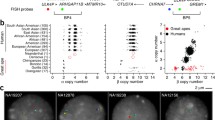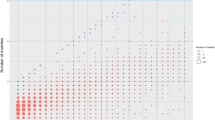Abstract
Human and chimpanzee karyotypes differ by virtue of nine pericentric inversions that serve to distinguish human chromosomes 1, 4, 5, 9, 12, 15, 16, 17, and 18 from their chimpanzee orthologues. In this study, we have analysed the breakpoints of the pericentric inversion characteristic of chimpanzee chromosome 4, the homologue of human chromosome 5. Breakpoint-spanning BAC clones were identified from both the human and chimpanzee genomes by fluorescence in situ hybridisation, and the precise locations of the breakpoints were determined by sequence comparisons. In stark contrast to some other characterised evolutionary rearrangements in primates, this chimpanzee-specific inversion appears not to have been mediated by either gross segmental duplications or low-copy repeats, although micro-duplications were found adjacent to the breakpoints. However, alternating purine–pyrimidine (RY) tracts were detected at the breakpoints, and such sequences are known to adopt non-B DNA conformations that are capable of triggering DNA breakage and genomic rearrangements. Comparison of the breakpoint region of human chromosome 5q15 with the orthologous regions of the chicken, mouse, and rat genomes, revealed similar but non-identical syntenic disruptions in all three species. The clustering of evolutionary breakpoints within this chromosomal region, together with the presence of multiple pathological breakpoints in the vicinity of both 5p15 and 5q15, is consistent with the non-random model of chromosomal evolution and suggests that these regions may well possess intrinsic features that have served to mediate a variety of genomic rearrangements, including the pericentric inversion in chimpanzee chromosome 4.





Similar content being viewed by others
References
Abeysinghe SS, Chuzhanova N, Krawczak M, Ball EV, Cooper DN (2003) Translocation and gross deletion breakpoints in human inherited disease and cancer. I: Nucleotide composition and recombination-associated motifs. Hum Mutat 22:229–244
Anderson K, Arvidsson I, Jacobsson B, Hast R (2002) Fluorescence in situ hybridization for the study of cell lineage involvement in myelodysplastic syndromes with chromosome 5 anomalies. Cancer Genet Cytogenet 136:101–107
Bacolla A, Wells RD (2004) Non-B DNA conformations, genomic rearrangements, and human disease. J Biol Chem 279:47411–47414
Bacolla A, Jaworski A, Larson JE, Jakupciak JP, Chuzhanova N, Abeysinghe SS, O’Connell CD, Cooper DN, Wells RD (2004) Breakpoints of gross deletions coincide with non-B DNA conformations. Proc Natl Acad Sci USA 101:14162–14167
Bailey JA, Baertsch R, Kent WJ, Haussler D, Eichler EE (2004) Hotspots of mammalian chromosomal evolution. Genome Biol 5:R23
Caceres M, Lachuer J, Zapala MA, Redmond JC, Kudo L, Geschwind DH (2003) Elevated gene expression levels distinguish human from non-human primate brains. Proc Natl Acad Sci USA 100:13030–13035
Caligiuri MA, Strout MP, Schichman SA, Mrozek K, Arthur DC, Herzig GP, Baer MR, Schiffer CA, Heinonen K, Knuutila S, Nousiainen T, Ruutu T, Block AW, Schulman P, Pedersen-Bjergaard J, Croce CM, Bloomfield CD (1996) Partial tandem duplication of ALL1 as a recurrent molecular defect in acute myeloid leukemia with trisomy 11. Cancer Res 56:1418–1425
Casas S, Aventin A, Fuentes F, Vallespi T, Granada I, Carrio A, Angel Martinez-Climent J, Sole F, Teixido M, Bernues M, Duarte J, Maria Hernandez J, Brunet S, Dolors Coll M, Sierra J (2004) Genetic diagnosis by comparative genomic hybridization in adult de novo acute myelocytic leukemia. Cancer Genet Cytogenet 153:16–25
Courseaux A, Richard F, Grosgeorge J, Ortola C, Viale A, Turc-Carel C (2003) Segmental duplications in euchromatic regions of human chromosome 5: a source of evolutionary instability and transcriptional innovation. Genome Res 13:369–381
Dennehey BK, Gutches DG, McConkey EH, Krauter KS (2004) Inversion, duplication, and changes in gene context are associated with human chromosome 18 evolution. Genomics 83:493–501
Dutrillaux B (1979) Chromosomal evolution in primates: tentative phylogeny from Microcebus murinus (Prosimian) to man. Hum Genet 48:251–314
Dutrillaux B, Rethore MO, Lejeune J (1975) Comparison of the karyotype of the orangutan (Pongo pygmaeus) to those of man, chimpanzee, and gorilla. Ann Genet 18:153161
Eder V, Ventura M, Ianigro M, Teti M, Rocchi M, Archidiacono N (2003). Chromosome 6 phylogeny in primates and centromere repositioning. Mol Biol Evol 20:1506–1512
Enard W, Khaitovich P, Klose J, Zollner S, Heissig F, Giavalisco P, Nieselt-Struwe K, Muchmore E, Varki A, Ravid R, Doxiadis GM, Bontrop RE, Paabo S(2002) Intra- and interspecific variation in primate gene expression patterns. Science 296:340–343
Fan Y, Linardopoulou E, Friedman C, Williams E, Trask BJ (2002) Genomic structure and evolution of the ancestral chromosome fusion site in 2q13–2q14.1 and paralogous regions on other human chromosomes. Genome Res 12:1651–1662
Frazer KA, Chen X, Hinds DA, Pant PV, Patil N, Cox DR (2003) Genomic DNA insertions and deletions occur frequently between humans and nonhuman primates. Genome Res 13:341–346
Goidts V, Szamalek JM, Hameister H, Kehrer-Sawatzki H (2004) Segmental duplication associated with the human specific inversion of chromosome 18: further example of the impact of segmental duplications on karyotype and genome evolution in primates. Hum Genet 115:116–122
Goidts V, Szamalek JM, de Jong PJ, Cooper DN, Chuzhanova N, Hameister H, Kehrer-Sawatzki H (2005) Independent intra-chromosomal recombination events underlie the pericentric inversions of chimpanzee and gorilla chromosomes homologous to human chromosome 16. Genome Res, in press.
Gusev VD, Nemytikova LA, Chuzhanova NA (1999) On the complexity measures of genetic sequences. Bioinformatics 15:994–999
Heller A, Loncarevic IF, Glaser M, Gebhart E, Trautmann U, Claussen U, Liehr T (2004) Breakpoint differentiation in chromosomal aberrations of hematological malignancies: identification of 33 previously unrecorded breakpoints. Int J Oncol 24:127–136
IJdo JW, Baldini A, Ward DC, Reeders ST, Wells RA (1991) Origin of human chromosome 2: an ancestral telomere-telomere fusion. Proc Natl Acad Sci USA 88:9051–9055
Karaman MW, Houck ML, Chemnick LG, Nagpal S, Chawannakul D, Sudano D, Pike BL, Ho VV, Ryder OA, Hacia JG (2003) Comparative analysis of gene-expression patterns in human and African great ape cultured fibroblasts. Genome Res 13:1619–1630
Kehrer-Sawatzki H, Schreiner B, Taenzer S, Platzer M, Müller S, Hameister H (2002) Molecular characterization of the pericentric inversion that causes differences between chimpanzee chromosome 19 and human chromosome 17. Am J Hum Genet 71:375–388
Kehrer-Sawatzki H, Sandig C, Chuzhanova N, Goidts V, Szamalek JM, Taenzer S, Müller S, Platzer M, Cooper DN, Hameister H (2005a) Breakpoint analysis of the pericentric inversion distinguishing human chromosome 4 from the homologous chromosome in the chimpanzee (Pan troglodytes). Hum Mutat 25:45–55
Kehrer-Sawatzki H, Sandig CA, Goidts V, Hameister H (2005b) Breakpoint analysis of the pericentric inversion between chimpanzee chromosome 10 and the homologous chromosome 12 in humans. Cytogenet Genome Res 108:91–97
Kehrer-Sawatzki H, Szamalek JM, Taenzer S, Platzer M, Hameister H (2005c) Molecular characterization of the pericentric inversion of chimpanzee chromosome 11 homologous to human chromosome 9. Genomics 85: 542–550
Khaitovich P, Muetzel B, She X, Lachmann M, Hellmann I, Dietzsch J, Steigele S, Do HH, Weiss G, Enard W, Heissig F, Arendt T, Nieselt-Struwe K, Eichler EE, Pääbo S (2004) Regional patterns of gene expression in human and chimpanzee brains. Genome Res 14:1462–1473
Locke DP, Archidiacono N, Misceo D, Cardone MF, Deschamps S, Roe B, Rocchi M, Eichler EE (2003) Refinement of a chimpanzee pericentric inversion breakpoint to a segmental duplication cluster. Genome Biol 4:R50
Mainardi PC, Perfumo C, Cali A, Coucourde G, Pastore G, Cavani S, Zara F, Overhauser J, Pierluigi M, Bricarelli FD (2001) Clinical and molecular characterisation of 80 patients with 5p deletion: genotype-phenotype correlation. J Med Genet 38:151–158
Marzella R, Viggiano L, Miolla V, Storlazzi CT, Ricco A, Gentile E, Roberto R, Surace C, Fratello A, Mancini M, Archidiacono N, Rocchi M (2000) Molecular cytogenetic resources for chromosome 4 and comparative analysis of phylogenetic chromosome IV in great apes. Genomics 63:307–313
McConkey EH (1997) The origin of human chromosome 18 from a human/ape ancestor. Cytogenet Cell Genet 76:189–191
Mendes-da-Silva P, Moreira A, Duro-da-Costa J, Matias D, Monteiro C (2000) Frequent loss of heterozygosity on chromosome 5 in non-small cell lung carcinoma. Mol Pathol 53:184–187
Montefalcone G, Tempesta S, Rocchi M, Archidiacono N (1999) Centromere repositioning. Genome Res 9:1184–1188
Müller S, Wienberg J (2001) “Bar-coding” primate chromosomes: molecular cytogenetic screening for the ancestral hominoid karyotype. Hum Genet 109:85–94
Müller S, Finelli P, Neusser M, Wienberg J (2004) The evolutionary history of human chromosome 7. Genomics 84:458–467
Nickerson E, Nelson DL (1998) Molecular definition of pericentric inversion breakpoints occurring during the evolution of humans and chimpanzees. Genomics 50:368–372
de Pontbriand A, Wang XP, Cavaloc Y, Mattei MG, Galibert F (2002) Synteny comparison between apes and human using fine-mapping of the genome. Genomics 80:395–401
Ruiz-Herrera A, Garcia F, Mora L, Egozcue J, Ponsa M, Garcia M (2005) Evolutionary conserved chromosomal segments in the human karyotype are bounded by unstable chromosome bands. Cytogenet Genome Res 108:161–174
Schmutz J, Martin J, Terry A et al (2004) The DNA sequence and comparative analysis of human chromosome 5. Nature 431:268–274
Shimada MK, Kim CG, Kitano T, Ferrell RE, Kohara Y, Saitou N (2005) Nucleotide sequence comparison of a chromosome rearrangement on human chromosome 12 and the corresponding ape chromosomes. Cytogenet Genome Res 108:83–90
Spitzner JR, Chung IK, Muller MT (1990) Eukaryotic topoisomerase II preferentially cleaves purine–pyrimidine repeats. Nucleic Acids Res 18:1–11
Stankiewicz P, Park SS, Inoue K, Lupski JR (2001) The evolutionary chromosome translocation 4;19 in Gorilla gorilla is associated with microduplication of the chromosome fragment syntenic to sequences surrounding the human proximal CMT1A-REP. Genome Res 11:1205–1210
Stankiewicz P, Shaw CJ, Withers M, Inoue K, Lupski JR (2004) Serial segmental duplications during primate evolution result in complex human genome architecture. Genome Res 14:2209–2220
Tsend-Ayush E, Grützner F, Yue Y, Grossmann B, Hansel U, Sudbrak R, Haaf T (2004) Plasticity of human chromosome 3 during primate evolution. Genomics 83:193–202
Uddin M, Wildman DE, Liu G, Xu W, Johnson RM, Hof PR, Kapatos G, Grossman LI, Goodman M (2004) Sister grouping of chimpanzees and humans as revealed by genome-wide phylogenetic analysis of brain gene expression profiles. Proc Natl Acad Sci USA 101:2957–2962
van Geel M, Eichler EE, Beck AF, Shan Z, Haaf T, van der Maarel SM, Frants RR, de Jong PJ (2002) A cascade of complex subtelomeric duplications during the evolution of the hominoid and Old World monkey genomes. Am J Hum Genet 70:269–278
Weise A, Starke H, Mrasek K, Claussen U, Liehr T (2005) New insights into the evolution of chromosome 1. Cytogenet Genome Res 108:217–222
Wienberg J, Jauch A, Stanyon R, Cremer T (1990) Molecular cytotaxonomy of primates by chromosomal in situ suppression hybridization. Genomics 8:347–350
Yunis JJ, Prakash O (1982) The origin of man: a chromosomal pictorial legacy. Science 215:1525–1530
Acknowledgements
This research was funded by the Deutsche Forschungsgemeinschaft (DFG KE 724/2-1).
Author information
Authors and Affiliations
Corresponding author
Rights and permissions
About this article
Cite this article
Szamalek, J.M., Goidts, V., Chuzhanova, N. et al. Molecular characterisation of the pericentric inversion that distinguishes human chromosome 5 from the homologous chimpanzee chromosome. Hum Genet 117, 168–176 (2005). https://doi.org/10.1007/s00439-005-1287-y
Received:
Accepted:
Published:
Issue Date:
DOI: https://doi.org/10.1007/s00439-005-1287-y




